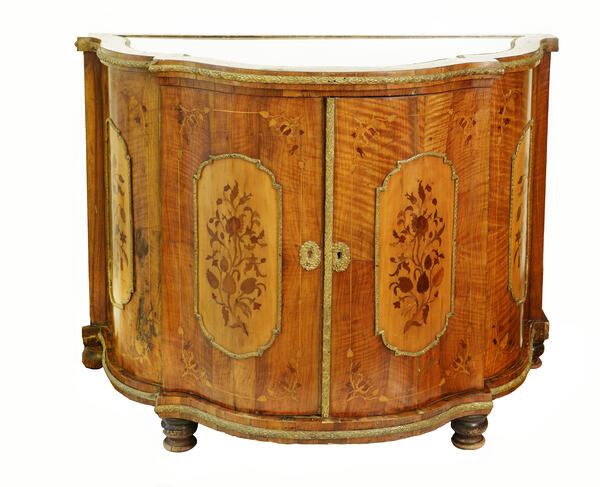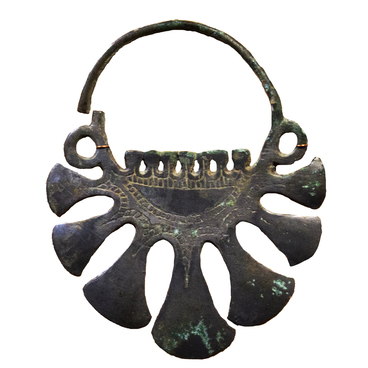The half-base unit, presented in the museum exhibition, is decorated in two techniques at once: “marquetry” and “pietra dura”.
The name “marquetry” comes from the French word “marquer”, which means “mark”, “draw”. The technique is one of the types of wood mosaic made from pieces of veneer (thin sheets of wood) of different species. This process has two stages. The first one is called “intarsia”: the master cuts pieces of wood of other shades into the background veneer according to a certain previously prepared pattern. The elements of the mosaic are fixed with paper smeared with glue. During the second stage — facing — the finished mosaic layer is glued to the surface of the item.
The marquetry technique appeared in the second half of the 16th century, after the invention of the machine for the production of sawn veneer. Furniture was made from local inexpensive wood and then veneered with valuable imported species: black, mahogany and rosewood. At the beginning of the 17th century, masters in Germany, Holland, and France began to work in this technique, and in the 18th century, it became known in Russia as well. It was used to decorate not only furniture but also interiors. The first Russian masters who mastered the technique of marquetry were serfs. Over time, wooden mosaics not only became a way of decorating furniture but also turned into an independent art form: they began to create real paintings from wood.
The tabletop of the museum half-base unit is decorated with stone mosaics using the “pietra dura” technique, which is translated from Italian as “ornamental stone”. This technique is also called Florentine, as it originated in Florence, Italy.
The sculptor Michelangelo Buonarroti called the Florentine mosaic “an eternal painting”.
For the manufacture of such a mosaic, precious and semi-precious stones were used: agate, amethyst, blue and green aventurine, carnelian, jasper, lapis lazuli, malachite, sodalite, tiger’s eye, serpentine, chalcedony, hematite (red iron ore), marble. The craftsmen selected stones of different colors, shades, and shapes, taking into account their natural pattern. This technique was especially popular in Europe from the 16th to the 19th century.
The name “marquetry” comes from the French word “marquer”, which means “mark”, “draw”. The technique is one of the types of wood mosaic made from pieces of veneer (thin sheets of wood) of different species. This process has two stages. The first one is called “intarsia”: the master cuts pieces of wood of other shades into the background veneer according to a certain previously prepared pattern. The elements of the mosaic are fixed with paper smeared with glue. During the second stage — facing — the finished mosaic layer is glued to the surface of the item.
The marquetry technique appeared in the second half of the 16th century, after the invention of the machine for the production of sawn veneer. Furniture was made from local inexpensive wood and then veneered with valuable imported species: black, mahogany and rosewood. At the beginning of the 17th century, masters in Germany, Holland, and France began to work in this technique, and in the 18th century, it became known in Russia as well. It was used to decorate not only furniture but also interiors. The first Russian masters who mastered the technique of marquetry were serfs. Over time, wooden mosaics not only became a way of decorating furniture but also turned into an independent art form: they began to create real paintings from wood.
The tabletop of the museum half-base unit is decorated with stone mosaics using the “pietra dura” technique, which is translated from Italian as “ornamental stone”. This technique is also called Florentine, as it originated in Florence, Italy.
The sculptor Michelangelo Buonarroti called the Florentine mosaic “an eternal painting”.
For the manufacture of such a mosaic, precious and semi-precious stones were used: agate, amethyst, blue and green aventurine, carnelian, jasper, lapis lazuli, malachite, sodalite, tiger’s eye, serpentine, chalcedony, hematite (red iron ore), marble. The craftsmen selected stones of different colors, shades, and shapes, taking into account their natural pattern. This technique was especially popular in Europe from the 16th to the 19th century.



